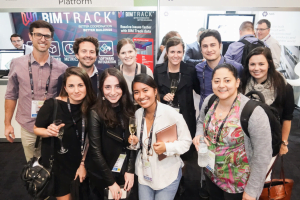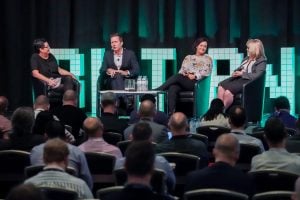The BILT ANZ Committee has significantly increased the number of women attending and speaking at their annual event through awareness raising of the importance of gender equity and a sponsorship initiative, says BILT ANZ committee member Ceilidh Higgins.

Gender equity with design technology is a big issue. For anyone who has ever attended any event with the words “BIM, digital technology or the future of construction” in the description, this has been obvious at a first glance for many years – a room full of men and a handful of women. Back in 2017, BILT ANZ probably reflected many other events, with a female participation rate ranging around 15%. Within two years, we have both increased the size of our event and increased the rate of female attendance to 21% – in real numbers, we now have more than double the number of women attending our event!
Why is gender equity important?
BILT is a unique event ‘by users, for users’ and in the Australia / New Zealand region has a very strong community of professionals who gather each year to share information and knowledge and try to improve the industry. The BILT ANZ committee believes that gender diversity stands to help improve our industry and our community. We want to improve gender diversity and support change in our wider industry. As well as standing to positively impact financial performance of organisations, gender diversity helps everyone by improving options for flexibility and work life balance, an issue that is also critical within our industry.
Identifying the problem
Back in 2017, when we began our journey to address this issue, BILT ANZ would typically attract around 400 professionals including architects and engineers, quantity surveyors, contractors and clients. Attendees would learn from 90+ speakers over three days about BIM, digital engineering and architecture, and a wide range of ways technology can help us work in the built environment. Technology is at the core of what we offer, but as a community we also offer a range of sessions on personal growth, building your career and softer skills that those managing people will need to support their technical skills. Our delegates were predominately male (85%) and our speaker ratio was even higher. While we realised that this was largely a reflection of industry, we were also aware that our own events in Europe and North America were achieving higher rates of female participation (closer to 20%) and we wanted to improve the situation.
First steps
Our audience tends to be at the forefront of change in technology and many are passionate about doing better work and making their workplaces better through technology. We wanted to take the opportunity to harness this spirit of change and we asked our community to help us to challenge our industry.
The first step to changing anything is to create awareness of the issue. While at first glance it’s obvious that our demographic was mostly men, we wanted our community to stop and to think about this – and to think about why. We wanted to demonstrate to our community that the BILT committee felt this was an important issue. We decided that part of our schedule for 2018 would include a panel to discuss gender – and that this panel would be on the main stage, in a dedicated session where no other classes would be running. We didn’t want this session to be a small class with only 20 women in the room, or a sideline to a keynote presentation. We wanted to raise awareness of the issue of gender, and particularly that gender and diversity isn’t just a women’s issue. We dedicated one of our keynote timeslots to this panel in order to demonstrate clearly to our community of delegates, speakers and sponsors that this issue was for everybody.
The session was titled “Challenging our Industry: Gender Diversity in AEC”. We dedicated a lot of time to selecting and briefing the panel. We knew that with our whole community in the room, we had to have a strong panel – bringing different points of view to bear. Our panel members were carefully selected as influential representatives of our industry or the broader technology industry. They did not to come from within our traditional community, in order to encourage more diverse viewpoints than might have been achieved by our own regular speakers and committee members participating. Our first step was choosing a well-regarded moderator who knew this issue and could help us with crafting the panel and discussion. We asked Justine Clark from Parlour if she would work with us and were delighted she accepted. We then invited panellists – Elizabeth Harper, Chief Information Officer at GHD, Todd Battley, CEO of AECOM ANZ, and Glenda Caldwell, Senior Lecturer at QUT. One of our committee members (that’s me!) spent time talking with Justine and each panel member to discuss the topic prior to the day. The aims of the session were to explore the questions:
- Why is gender diversity important?
- How does gender diversity benefit everyone?
- What can an individual be doing to help promote change?
You can find more on the discussion here. During the session, it was great to see a number of our delegates quoting and commenting on the panel via Twitter. Over the remaining two days of the conference, I had many conversations with delegates and speakers (both male and female) on the issues discussed, and overheard many more. We made a great start at raising awareness and generating discussion – but what next?

Disrupting the status quo
For the committee the big question was what could we do next – how can we disrupt the status quo and change the event? For the next few months, we pondered a variety of ideas, from giving away free tickets to seeking out more female speakers. Members of the committee spoke and wrote about the panel session and what we were aiming to achieve.
Our annual cycle starts with requested abstracts and selecting speakers, and we were pleased to see we had a higher ratio of women submitting sessions for the 2019 event, although we had not focused particularly on improving our speaker ratios.
Scholarships
Around this time, we decided that our next big step forward would be to offer scholarships to help boost the number of women attending our event. However, we didn’t want to create a point of difference for men and women and be accused of unfairly benefitting women.
We had determined that one barrier to women attending our ANZ event was the fact many women work part-time. Employers are much less likely to send a part-time woman to a three-day conference than a full-time man. So, our first scholarship offering was three positions, for those working part-time or on maternity/paternity leave. We also approached Todd Battley, who offered his support and AECOM generously sponsored five more scholarships specifically for women.
The scholarships program was a key focus of our marketing leading up to the 2019 event. We continued to talk about the importance of gender diversity and our aim to create more opportunities for women to attend our event. We were supported in this by Women in BIM, AECOM and through our community on LinkedIn and Twitter.
Increased numbers and visibility
Each week I nervously watched the registration statistics. The percentage of women was higher than last year, but would this still be the case when we received all the last-minute registrations? In fact, it climbed week by week and the night before the event we knew we had succeeded in creating real and meaningful change. We had more than 600 delegates, and 21% were women. The increase in numbers was significant and well beyond the number of scholarships on offer.
We also did a final count of the number of female speakers, co-speakers and panellists. Again, we had achieved a significant increase, taking the participation of women from 9% to 22%! Without actively addressing the issue of female speakers, we believe that our focus on the issue has contributed to this staggering increase. Perhaps women feel more comfortable putting their name forward for an event that so clearly demonstrates it values women. Our male speakers are more aware of the issue and perhaps are more likely to ask a woman to be part of a panel, or to mentor a new female speaker.
At the event itself, the increase in women was visible (a case in point: I even had to queue for the female bathrooms). While we didn’t have any sessions dedicated to the issue in 2019, talk of our scholarships program and our achievements in increasing female participation featured on the main stage and social media, and our “Women in BIM” lunch attracted double the numbers that our 2018 lunch did – seeing an increase in both women and men in the room.
We believe that our success has been largely based upon getting the word out to our community and potential members of our community. The fact that our committee members, both male and female, are genuinely committed to this issue and improving the industry has been noticed. By talking about gender and facing the issue, we signal that women are welcome at our event and as part of our community.
For us, it’s clear that the gender imbalance in construction and in technology isn’t just going to go away overnight, or after one successful event. As we move into the planning cycle for next year’s event, we are thinking about what to do next.
Next steps
We have begun adjusting our systems to allow us to conduct abstract reviews without knowledge of the speaker’s identity or gender (notwithstanding any giveaways in the abstract body). We’ve been wanting to do this for a while but hampered by the software we were using. This way we can review speakers and their abstracts independently, further removing inherent biases for all speakers.
We are keen to make available more scholarships – both provided by the Digital Built Environment Institute (DBEI) and through sponsors. We allow the sponsors leeway in the criteria they use (they may only wish to select women, whereas we are less prescriptive). This increases female representation among the attendee base as well as the overall size of the attendee base itself. Further ideas will likely develop and progress over the next six months. You can read more about Gender Diversity at BILT ANZ here.
The 2020 event will be held in Sydney from 18 to 20 June, and BILT ANZ is now accepting abstracts until 17 November. You can find further details on the BILT ANZ website. If you or any women you know are interested in speaking or sponsoring, please get in touch now. Otherwise, mark the dates in your diary. We are looking forward to another fantastic event and being able to share further stories of our success in creating a better industry for everyone.
Ceilidh Higgins is the Interior Design Leader for Custance Associates, leading their team delivering workplace and educational projects. Her speciality is work – both the places we work and the way we work. Ceilidh is also active within both the green building and the BIM communities. In 2017 she joined the BILT ANZ (formerly RTC) organising committee after many years as regular speaker at RTC both in Australia and internationally.
Ceilidh also researches, writes and speculates on the future of work (see The Midnight Lunch) – both as a place and the processes of working within the AEC industry – and the impacts of technology upon both.




















